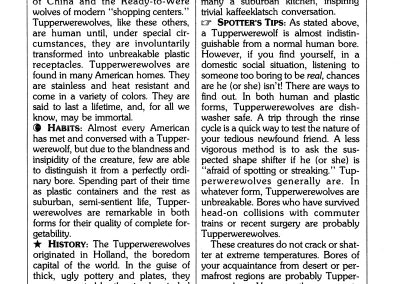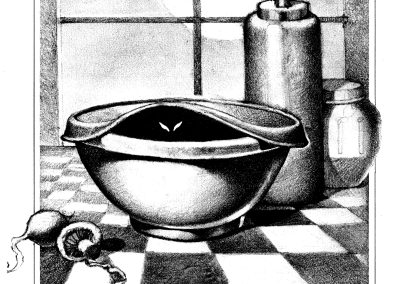TUPPERWEREWOLVES
Tedium domesticum
RANGE: Tupperwerewolves are little-known members of the larger group of supernatural beings known as shape shifters; it includes such monstrosities as the Werewolves (of London), the Were-bears (known to the American Indians), the Were-foxes of China and the Ready-to-Were wolves of modem “shopping centers.” Tupperwerewolves, like these others, are human until, under special circumstances, they are involuntarily transformed into unbreakable plastic receptacles. Tupperwerewolves are found in many American homes. They are stainless and heat resistant and come in a variety of colors. They are said to last a lifetime, and, for all we know, may be immortal.
HABITS: Almost every American has met and conversed with a Tupperwerewolf, but due to the blandness and insipidity of the creature, few are able to distinguish it from a perfectly ordinary bore. Spending part of their time as plastic containers and the rest as suburban, semi-sentient life, Tupperwerewolves are remarkable in both forms for their quality of complete for-getability.
HISTORY: The Tupperwerewolves originated in Holland, the boredom capital of the world. In the guise of thick, ugly pottery and plates, they were venerated by the simple-minded Dutch, who gave them places of honor upon grotesquely carved cabinets in the comers of their kitchens. (It has been argued that the word “Elf” is itself but a corruption of the Dutch word “Delft.”) After arriving in America, Tupperwerewolves adopted a more resilient form, and lurk to this day in many a suburban kitchen, inspiring trivial kaffeeklatsch conversation.
SPOTTER’S TIPS: As stated above, a Tupperwerewolf is almost indistinguishable from a normal human bore. However, if you find yourself, in a domestic social situation, listening to someone too boring to be real, chances are he (or she) isn’t! There are ways to find out. In both human and plastic forms, Tupperwerewolves are dishwasher safe. A trip through the rinse cycle is a quick way to test the nature of your tedious newfound friend. A less vigorous method is to ask the suspected shape shifter if he (or she) is “afraid of spotting or streaking.” Tupperwerewolves generally are. In whatever form, Tupperwerewolves are unbreakable. Bores who have survived head-on collisions with commuter trains or recent surgery are probably Tupperwerewolves. These creatures do not crack or shatter at extreme temperatures. Bores of your acquaintance from desert or permafrost regions are probably Tupperwerewolves. You can throw a party and find out.



0 Comments